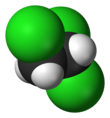| |||
| Names | |||
|---|---|---|---|
| Preferred IUPAC name 1,1,2-Trichloroethane | |||
| Other names
1,1,2-TCA vinyl trichloride symmetrical Trichloroethane monochlorethylen chloride (archaic) | |||
| Identifiers | |||
| CAS Number | |||
| 3D model (JSmol) | |||
| ChEBI | |||
| ChEMBL | |||
| ChemSpider | |||
| ECHA InfoCard | 100.001.061 | ||
| KEGG | |||
| PubChem CID | |||
| UNII | |||
| CompTox Dashboard (EPA) | |||
InChI
| |||
SMILES
| |||
| Properties | |||
| Chemical formula | C2H3Cl3 | ||
| Molar mass | 133.40 g/mol | ||
| Appearance | colorless liquid | ||
| Odor | sweet, chloroform-like (in high concentrations) | ||
| Density | 1.435 g/cm | ||
| Melting point | −37 °C (−35 °F; 236 K) | ||
| Boiling point | 110 to 115 °C (230 to 239 °F; 383 to 388 K) | ||
| Solubility in water | 0.4% (20°C) | ||
| Vapor pressure | 19 mmHg (20°C) | ||
| Hazards | |||
| NFPA 704 (fire diamond) |
 | ||
| Explosive limits | 6–15.5% | ||
| Lethal dose or concentration (LD, LC): | |||
| LD50 (median dose) | 1200 mg/kg (rat, orally) | ||
| LCLo (lowest published) | 13,100 mg/m (cat, 4.5 hr) 2000 ppm (rat, 4 hr) | ||
| NIOSH (US health exposure limits): | |||
| PEL (Permissible) | TWA 10 ppm (45 mg/m) | ||
| REL (Recommended) | Ca TWA 10 ppm (45 mg/m) | ||
| IDLH (Immediate danger) | Ca | ||
| Related compounds | |||
| Related compounds | 1,1,1-Trichloroethane; Trichloroethylene | ||
| Except where otherwise noted, data are given for materials in their standard state (at 25 °C , 100 kPa).
| |||
1,1,2-Trichloroethane, vinyl trichloride or 1,1,2-TCA, is an organochloride solvent with the molecular formula C2H3Cl3 and the structural formula CH2Cl—CHCl2. It is a colourless, sweet-smelling liquid that does not dissolve in water, but is soluble in most organic solvents. It is an isomer of 1,1,1-trichloroethane, and a byproduct of its manufacture.
It is used as a solvent and as an intermediate in the synthesis of 1,1-dichloroethylene.
Toxicity
1,1,2-Trichloroethane may be harmful by inhalation, ingestion, and skin contact. It is a respiratory and eye irritant. 1,1,2-TCA is a central nervous system depressant and inhalation of vapors may cause dizziness, drowsiness, headache, nausea, shortness of breath, and unconsciousness.
The Occupational Safety and Health Administration and National Institute for Occupational Safety and Health have set occupational exposure limits to 1,1,2-Trichloroethane at 10 ppm over an eight-hour time-weighted average.
References
- ^ NIOSH Pocket Guide to Chemical Hazards. "#0628". National Institute for Occupational Safety and Health (NIOSH).
- 1,1,2-Trichloroethane toxicity
- "1,1,2-Trichloroethane". Immediately Dangerous to Life or Health Concentrations (IDLH). National Institute for Occupational Safety and Health (NIOSH).
- Toxicological profile for 1,1,2-trichloroethane (PDF) (Report). Agency for Toxic Substances and Disease Registry (ATSDR). March 2021. Archived (PDF) from the original on 2022-03-05. Retrieved 2023-08-23.
- "Safety (MSDS) data for 1,1,2-trichloroethane" (PDF).
- CDC - NIOSH Pocket Guide to Chemical Hazards

